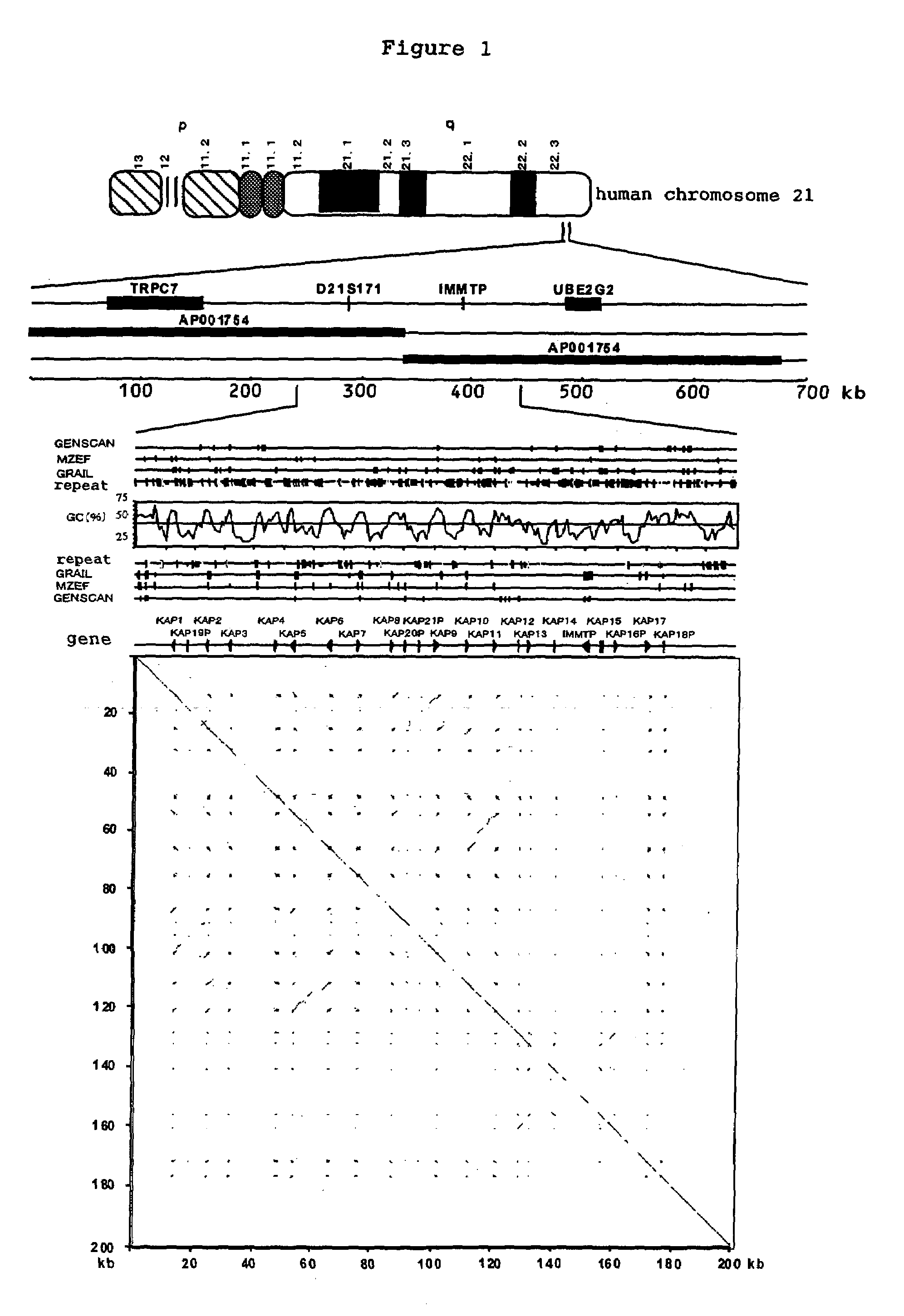Hair keratin-associated proteins
a technology of keratin and protein, which is applied in the direction of cytokeratin, peptides, drug compositions, etc., can solve the problems of tissue permeability in an intact size, and achieve the effects of promoting or suppressing hair keratin binding activity, and promoting or suppressing the expression of said protein
- Summary
- Abstract
- Description
- Claims
- Application Information
AI Technical Summary
Benefits of technology
Problems solved by technology
Method used
Image
Examples
example 1
Identification of Low-Frequency Repetitive Sequences in the Base Sequence of Long Arm Region of Chromosome 21
[0078]As one of the project of human genome, with international collaboration, the base sequence of the euchromatic region of chromosome 21 which is approximately 33.5 Mb was determined, and the presence or the absence of low-frequency repetitive sequences in the base sequence of long arm region of chromosome 21 (21q22.3) was searched by dot-matrix analysis. The results are shown in FIG. 1. As a result, it has been clarified that 21 short sequences of approximately 0.05–1.2 kb are disseminated for 163.5 kb in 21q22.3, and form a cluster. By performing homology search to the above 21 repetitive sequences, it was observed that these genes had significant homology with mouse Krtapl2-1 and rabbit KAP4L, which are members of KAP, and further with mouse gUHS-SER-1 and gUHS-SER-2. From these results, it had been clarified that these genes are KAP that belongs to high sulfur protein ...
example 2
Analysis of Each KAP Sequence in Long Arm Region of Human Chromosome 21
[0079]From the results mentioned above, the amino acid sequence of each KAP protein that are encoded by 16 genes forming a cluster, comprising the base sequence shown in Seq. ID No. 2n−1 (n shows any integer from 1 to 16) were determined as shown in Seq. ID No. 2n (n shows any integer from 1 to 16), and the identity between amino acids was examined. The results are shown in FIGS. 2 and 3. Moreover, the phylogenetic tree of KAP gene cluster of 21q22.3 was constructed with the use of DNASIS V3.5 (HITACHI SOFTWARE ENGINEERING CO., LTD) and Clustal W VERSION 1.4 (Nucleic Acids Res. 22, 4673–4680, 1994), by the neighbor-joining method. These results are shown in FIGS. 4 and 5. From these results, it has been clear that human KAP can be classified in 2 sub-families (KAP01-11 and 17), (KAP12-15)], but no significant homology was observed among the families at DNA base level. However, it is very interesting from the poin...
example 3
Gene Expression Site of Human KAP by RT-PCR)
[0081]Total RNA was extracted from human hair root or skin by guanidine-cesium chloride method, the extracted total RNA was treated with RNase-free DNase (Nippon Gene). 5 μg each of the obtained RNA was used, and a single-stranded cDNA (RT′) was prepared with the use of reverse transcriptase (Invitrogen) and oligo dT18 primer, and was amplified by PCR. Those not performing reverse transcription reaction were used as negative control (RT). Primers P1–P38 used for PCR, as set forth in Seq. ID Nos. 79–116, respectively, and PCR conditions are shown in [Table 1].
[0082]
TABLE 1annealingtemp.forward primerreverse primer(° C.)enzyme*KAP01P1TCACTCACTCACACCTCCCGP2GAGACACGGGGACCCGTCCT55HFKAP02P3TCACTCACTCACACACCTCCCCP4ATCCCCAACCAGCGACCAGCGA55HFKAP03P5TCACTCACTCACGTCTCCCCP6AACTCTGGAGAAACGGGACC55HFKAP04P7AGCTCAACCCCCAGCACAGCAP8GTCAAAGTGCAGGAGCAATTC55HFKAP05P9CCAGCTCACGTCTTCCCCACP10CCTAACCCGAGTCAGGACCA55HFKAPO6P11CTCCACCAGTTCAACCCCAGCATP12TAAGACAAAGAGCC...
PUM
| Property | Measurement | Unit |
|---|---|---|
| frequency | aaaaa | aaaaa |
Abstract
Description
Claims
Application Information
 Login to View More
Login to View More - R&D
- Intellectual Property
- Life Sciences
- Materials
- Tech Scout
- Unparalleled Data Quality
- Higher Quality Content
- 60% Fewer Hallucinations
Browse by: Latest US Patents, China's latest patents, Technical Efficacy Thesaurus, Application Domain, Technology Topic, Popular Technical Reports.
© 2025 PatSnap. All rights reserved.Legal|Privacy policy|Modern Slavery Act Transparency Statement|Sitemap|About US| Contact US: help@patsnap.com



